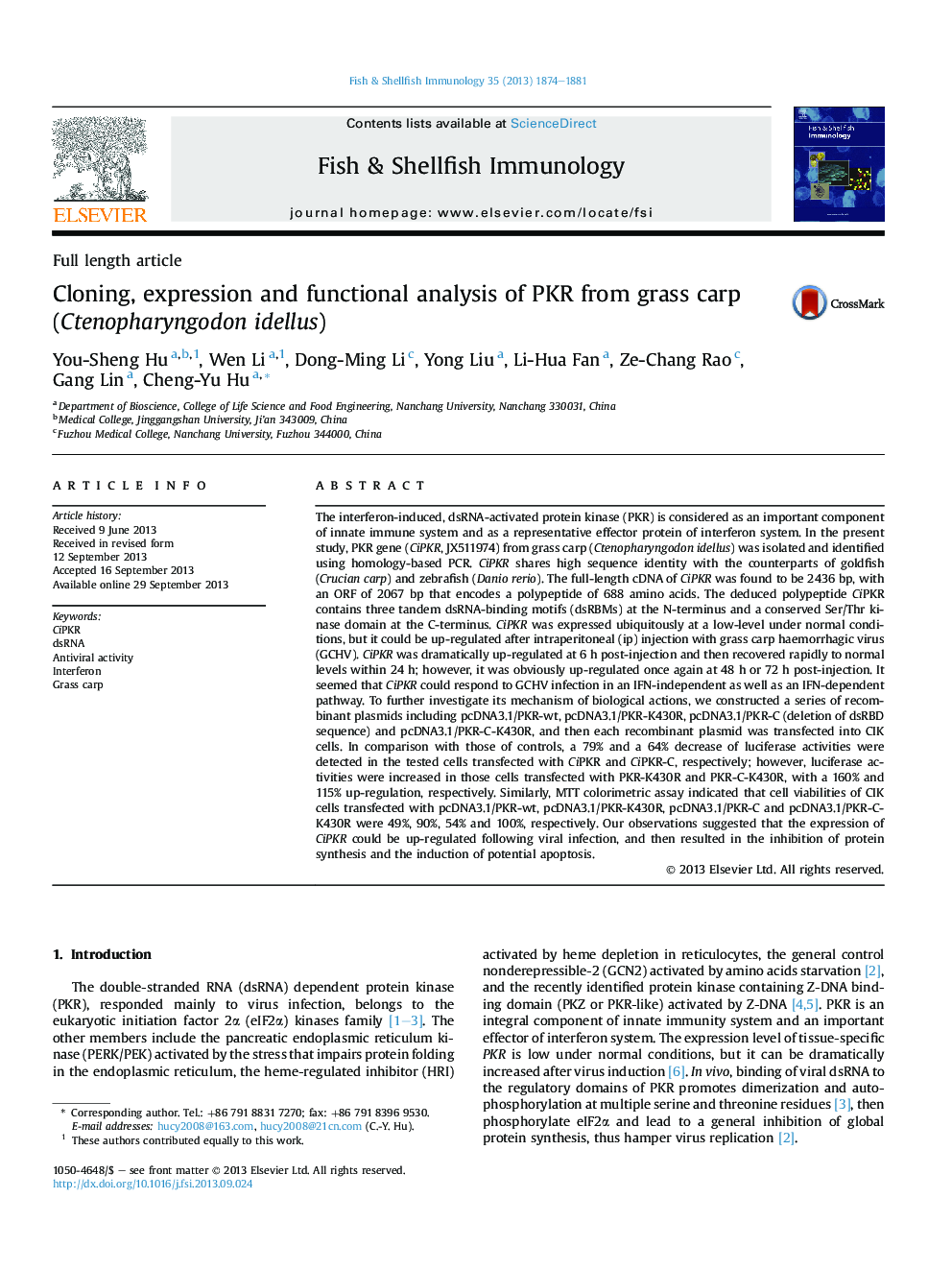| کد مقاله | کد نشریه | سال انتشار | مقاله انگلیسی | نسخه تمام متن |
|---|---|---|---|---|
| 2431543 | 1106763 | 2013 | 8 صفحه PDF | دانلود رایگان |

• The full-length cDNA of grass carp PKR (CiPKR) was cloned and identified.
• CiPKR could respond to GCHV infection in IFN-independent or IFN-dependent pathway.
• Overexpression of CiPKR-induced cell apoptosis via inhibiting protein synthesis.
The interferon-induced, dsRNA-activated protein kinase (PKR) is considered as an important component of innate immune system and as a representative effector protein of interferon system. In the present study, PKR gene (CiPKR, JX511974) from grass carp (Ctenopharyngodon idellus) was isolated and identified using homology-based PCR. CiPKR shares high sequence identity with the counterparts of goldfish (Crucian carp) and zebrafish (Danio rerio). The full-length cDNA of CiPKR was found to be 2436 bp, with an ORF of 2067 bp that encodes a polypeptide of 688 amino acids. The deduced polypeptide CiPKR contains three tandem dsRNA-binding motifs (dsRBMs) at the N-terminus and a conserved Ser/Thr kinase domain at the C-terminus. CiPKR was expressed ubiquitously at a low-level under normal conditions, but it could be up-regulated after intraperitoneal (ip) injection with grass carp haemorrhagic virus (GCHV). CiPKR was dramatically up-regulated at 6 h post-injection and then recovered rapidly to normal levels within 24 h; however, it was obviously up-regulated once again at 48 h or 72 h post-injection. It seemed that CiPKR could respond to GCHV infection in an IFN-independent as well as an IFN-dependent pathway. To further investigate its mechanism of biological actions, we constructed a series of recombinant plasmids including pcDNA3.1/PKR-wt, pcDNA3.1/PKR-K430R, pcDNA3.1/PKR-C (deletion of dsRBD sequence) and pcDNA3.1/PKR-C-K430R, and then each recombinant plasmid was transfected into CIK cells. In comparison with those of controls, a 79% and a 64% decrease of luciferase activities were detected in the tested cells transfected with CiPKR and CiPKR-C, respectively; however, luciferase activities were increased in those cells transfected with PKR-K430R and PKR-C-K430R, with a 160% and 115% up-regulation, respectively. Similarly, MTT colorimetric assay indicated that cell viabilities of CIK cells transfected with pcDNA3.1/PKR-wt, pcDNA3.1/PKR-K430R, pcDNA3.1/PKR-C and pcDNA3.1/PKR-C-K430R were 49%, 90%, 54% and 100%, respectively. Our observations suggested that the expression of CiPKR could be up-regulated following viral infection, and then resulted in the inhibition of protein synthesis and the induction of potential apoptosis.
Journal: Fish & Shellfish Immunology - Volume 35, Issue 6, December 2013, Pages 1874–1881